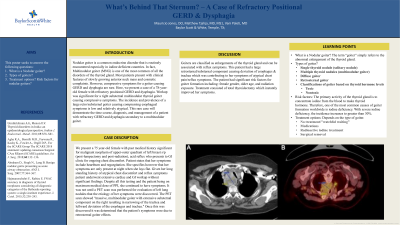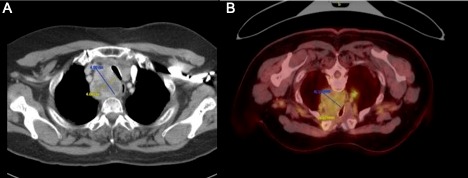Monday Poster Session
Category: Esophagus
P1889 - What’s Behind That Sternum? – A Case of Refractory Positional GERD & Dysphagia
Monday, October 23, 2023
10:30 AM - 4:15 PM PT
Location: Exhibit Hall

Has Audio

Mauricio Jones, DO
Baylor Scott & White
Temple, TX
Presenting Author(s)
Mauricio Jones, DO1, Matthew Tjahja, MD, MS1, Vani Paleti, MD2
1Baylor Scott & White, Temple, TX; 2BSWH, Killeen, TX
Introduction: Nodular goiter is a common endocrine disorder that is routinely encountered especially in iodine deficient countries. In fact, Multinodular goiter (MNG) is one of the most common of all the disorders of the thyroid gland. Most patients present with clinical features of slowly growing anterior neck mass and cosmetic complaints. However, compressive symptoms for a goiter causing GERD and dysphagia are rare. Here, we present a case of a 78-year-old female with refractory positional GERD and dysphagia. Workup was significant for a right substernal multinodular thyroid goiter causing compressive symptoms. The incidence and prevalence of a large retro/substernal goiter causing compressing esophageal symptoms is low and relatively atypical. This rare case will demonstrate the time course, diagnosis, and management of a patient with refractory GERD and dysphagia secondary to a multinodular goiter.
Case Description/Methods: We present a 75 year-old female with past medical history significant for malignant neoplasm of upper-outer quadrant of left breast s/p (post-lumpectomy and post-radiation), acid reflux who presents to GI clinic for ongoing chest discomfort. Patient states that her symptoms include heartburn and regurgitation. She specifies however that her symptoms are only present at night when she lays flat. Given her long standing history of atypical chest discomfort and reflux symptoms patient underwent extensive cardiac and GI workup without significant findings. Despite all this testing and the patient being on maximum medical dose of PPI, she continued to have symptoms. It was not until a PET scan was performed for evaluation of left lung nodules that the etiology of her symptoms were discovered. The PET scan showed "massive, multinodular goiter with extensive substernal component on the right resulting in narrowing of the trachea and leftward deviation of the esophagus and trachea." Once this was discovered it was determined that the patient’s symptoms were due to retrosternal goiter effects.
Discussion: Goiters are classified as enlargements of the thyroid gland and can be associated with reflux symptoms. This patient had a large retrosternal/substernal component causing deviation of esophagus & trachea which was contributing to her symptoms of atypical chest pain/reflux symptoms. The patient had significant risk factors for goiter formation including: female gender, older age, and radiation exposure. Treatment consisted of total thyroidectomy which instantly improved her symptoms.

Disclosures:
Mauricio Jones, DO1, Matthew Tjahja, MD, MS1, Vani Paleti, MD2. P1889 - What’s Behind That Sternum? – A Case of Refractory Positional GERD & Dysphagia, ACG 2023 Annual Scientific Meeting Abstracts. Vancouver, BC, Canada: American College of Gastroenterology.
1Baylor Scott & White, Temple, TX; 2BSWH, Killeen, TX
Introduction: Nodular goiter is a common endocrine disorder that is routinely encountered especially in iodine deficient countries. In fact, Multinodular goiter (MNG) is one of the most common of all the disorders of the thyroid gland. Most patients present with clinical features of slowly growing anterior neck mass and cosmetic complaints. However, compressive symptoms for a goiter causing GERD and dysphagia are rare. Here, we present a case of a 78-year-old female with refractory positional GERD and dysphagia. Workup was significant for a right substernal multinodular thyroid goiter causing compressive symptoms. The incidence and prevalence of a large retro/substernal goiter causing compressing esophageal symptoms is low and relatively atypical. This rare case will demonstrate the time course, diagnosis, and management of a patient with refractory GERD and dysphagia secondary to a multinodular goiter.
Case Description/Methods: We present a 75 year-old female with past medical history significant for malignant neoplasm of upper-outer quadrant of left breast s/p (post-lumpectomy and post-radiation), acid reflux who presents to GI clinic for ongoing chest discomfort. Patient states that her symptoms include heartburn and regurgitation. She specifies however that her symptoms are only present at night when she lays flat. Given her long standing history of atypical chest discomfort and reflux symptoms patient underwent extensive cardiac and GI workup without significant findings. Despite all this testing and the patient being on maximum medical dose of PPI, she continued to have symptoms. It was not until a PET scan was performed for evaluation of left lung nodules that the etiology of her symptoms were discovered. The PET scan showed "massive, multinodular goiter with extensive substernal component on the right resulting in narrowing of the trachea and leftward deviation of the esophagus and trachea." Once this was discovered it was determined that the patient’s symptoms were due to retrosternal goiter effects.
Discussion: Goiters are classified as enlargements of the thyroid gland and can be associated with reflux symptoms. This patient had a large retrosternal/substernal component causing deviation of esophagus & trachea which was contributing to her symptoms of atypical chest pain/reflux symptoms. The patient had significant risk factors for goiter formation including: female gender, older age, and radiation exposure. Treatment consisted of total thyroidectomy which instantly improved her symptoms.

Figure: A. CT – showing retrosternal thyroid compressing trachea anteriorly and esophagus laterally ( usually esophagus is posterior to the trachea)
B. PET scan - showing retrosternal thyroid compressing trachea anteriorly and esophagus laterally
B. PET scan - showing retrosternal thyroid compressing trachea anteriorly and esophagus laterally
Disclosures:
Mauricio Jones indicated no relevant financial relationships.
Matthew Tjahja indicated no relevant financial relationships.
Vani Paleti indicated no relevant financial relationships.
Mauricio Jones, DO1, Matthew Tjahja, MD, MS1, Vani Paleti, MD2. P1889 - What’s Behind That Sternum? – A Case of Refractory Positional GERD & Dysphagia, ACG 2023 Annual Scientific Meeting Abstracts. Vancouver, BC, Canada: American College of Gastroenterology.
